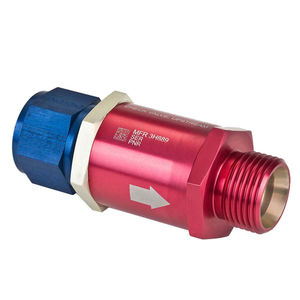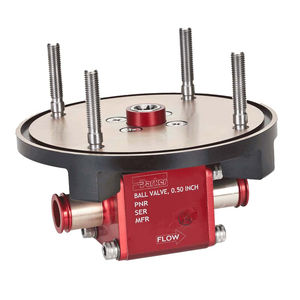
- Hydraulics - Pneumatics
- Valve
- Float valve
- Parker Cylinder Division Europe
Float valve FSDVntVlv enginefuelvent
Add to favorites
Compare this product
Characteristics
- Operation
- float
- Applications
- engine, fuel
- Associated function
- vent
- Other characteristics
- actuated, vertical
- Pressure
Max.: 5 psi
Min.: 0 psi
- Temperature
Max.: 131 °F
(55 °C)Min.: -58 °F
(-50 °C)
Description
Vent valves are often installed to close the vent lines when fuel is present. As fuel rises in the tank, the float swings up due to buoyancy forces until the poppet mates against the housing.
In order to prevent or minimize the opportunity for vent lines to become filled with fuel, float actuated vent valves are often installed that -
close the vent lines when fuel is present. The float is normally in the open position when the fluid is in the tank is below a certain level. As fuel -
rises in the tank, the loat swings up due to buoyancy forces until the poppet mates against the housing. Parker has designed several float -
valves that look similarly to the one pictured. -
The material and finishes used in the construction of the valve and those of similar, previously qualified valves are unaffected by several -
environmental conditions listed in RTCA DO-160 and MIL-STD-810. This elegantly simple design is extremely reliable and several variations of -
this valve have been produced by Parker for over 30 years. -
Float vent valves such as the one above are mounted to a vertical rib, but variations of the design shown have been mounted to a horizontal -
plane. Due to the increasing demands in aerospace, several float vent valves have also been designed to handle windmilling and engine blade -
out requirements as well as external Icing. -
The material of the float is based off a proprietary polyurethane foam material. The density of the material can be altered for design -
purposes and is molded around the arm, thus eliminating the need for a secondary mechanical attachment.
Catalogs
No catalogs are available for this product.
See all of Parker Cylinder Division Europe‘s catalogsOther Parker Cylinder Division Europe products
Aerospace Valves
Related Searches
*Prices are pre-tax. They exclude delivery charges and customs duties and do not include additional charges for installation or activation options. Prices are indicative only and may vary by country, with changes to the cost of raw materials and exchange rates.











